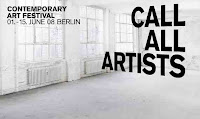
NEW LIFE BERLIN, 1-15 June 2008, http://www.wooloo.org/festival/, is a contemporary art festival dedicated to new modes of moving and existing and is structured along three themes :
Transnational Communities. What do ‘community’ and ‘identity’ mean today? Presenting projects from both artistic and sociological starting points, New Life Berlin will use group participation to explore real-life cultural mobility.
Artistic Social Responsibility. What is the relationship between cultural practitioners and corporate entities in the new millennium? How does contemporary cultural production relate to the concept of “Corporate Social Responsibility”?
Participation and Intervention. How do participatory arts practices affect the socio-cultural environments in which they take place? How and why can local audiences become involved in artists’ projects, and what does their involvement mean in terms of civic engagement and social empowerment?
For New Life Berlin, Open Dialogues will be building a tailor-made programme of live events, textual interventions and writing that responds critically to the socially engaged and collaborative work shown. We will be developing a community of writers who will explore online and offline communities during the New Life Berlin Festival, develop organic responses to the Festival and investigate the implications and role of critical writing.
We are asking local and international writers to participate in OPEN DIALOGUES: NEW LIFE BERLIN, which acts as a professional development programme for new and existing writers. Each participating writer will be supported in writing, publishing and editing their work as well as briefed current trends in critial writing. You will also gain a unique insight into the participatory, live and socially engaged work at New Life Berlin. We are looking for writers of all ages to participate. You will need to be fluent in written and spoken English (you will also have the opportunity to write in German), have a strong interest in contemporary art practice and be willing to write accessibly for both art and non-art audiences. You will also need to have a minimum of a university degree (BA) in a related field.
Writers must be able to commit to one full day’s writing workshop, two 2 hour peer-critique sessions, at least one OPEN DIALOGUES: NEW LIFE BERLIN event and to writing at least three texts throughout the festival.
For more details see http://www.wooloo.org/opendialogues/. If you would like to participate please contact opendialogues@gmail.com
